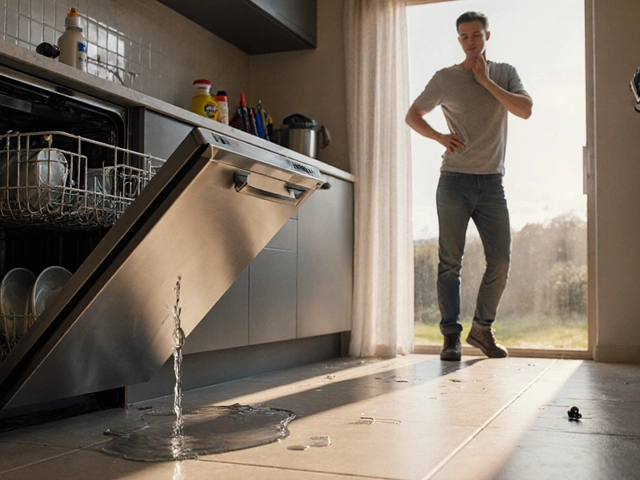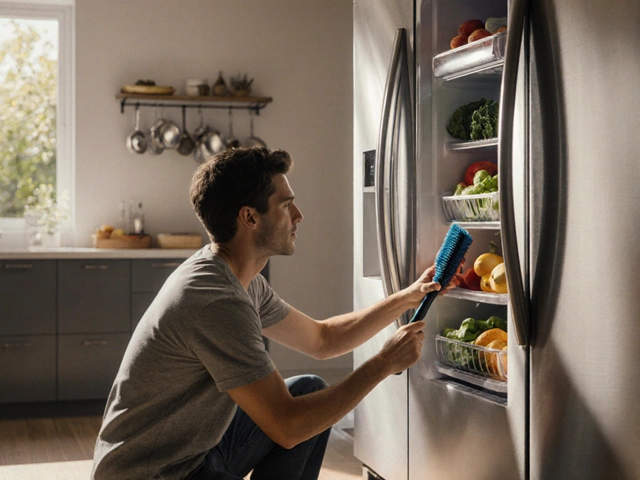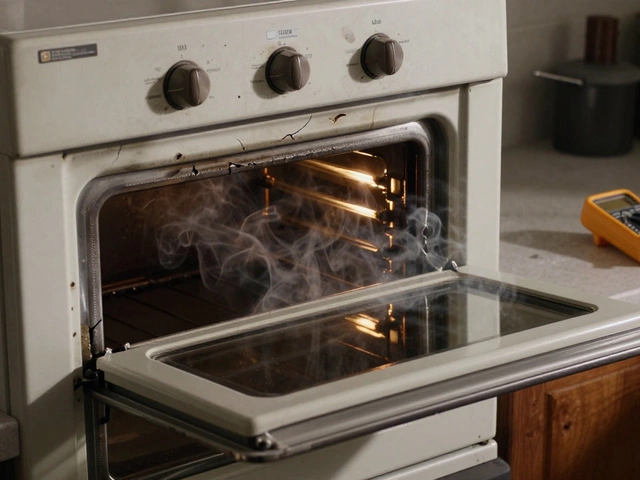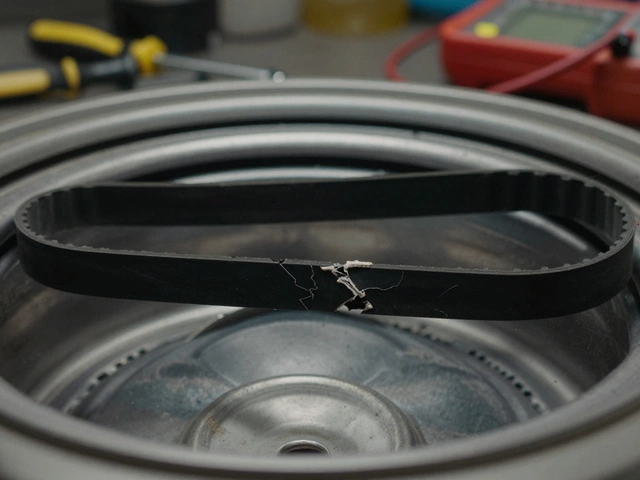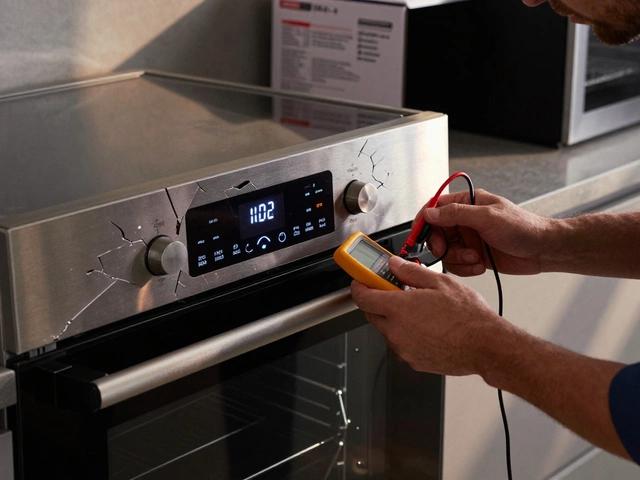Every homeowner has pondered whether to repair or replace a troublesome appliance. Your washing machine, a trusted workhorse in your household, may face this dilemma when it starts showing signs of fatigue or malfunction.
As you stare at the pile of clothes waiting to be washed, the decision looms large. Are you better off sinking money into fixing your current machine or shopping for a new one? In this guide, we dive into the heart of this issue, giving you the tools you need to make a wise and informed choice.
- Consider the Age and Condition
- Repair Costs vs Replacement
- Common Washing Machine Issues
- DIY Repairs and Maintenance
- When to Call a Professional
- Tips to Extend Machine Lifetime
Consider the Age and Condition
When it comes to washing machine repair, the first thing to ponder is not just the symptoms but the age of the appliance itself. A typical washing machine has a lifespan of about 10 to 15 years, depending on the brand and how well it's been maintained. If your washer is reaching the double digits, you might need to brace yourself for the inevitability of more frequent breakdowns. Older machines, while nostalgic and sometimes sturdier, often lack the energy-efficiency and features offered by newer models. This doesn't mean you should run out and buy a new one at the first hiccup, but take a moment to think about how long you've had it and whether it's been running smoothly until now.
There are many sleuthing questions to ask about the condition. Has the machine been humming along with just minor hiccups, or have parts been replaced almost as regularly as the laundry is done? Check for rust or leaks, which might indicate structural weaknesses or hidden damages. An occasional belt replacement, for instance, is less concerning than an intermittent loss of power or strange mechanical noises. If your washer has led a hard life in a busy household, it's bound to start showing signs of wear sooner. Environmentally, frequent breakdowns contribute to waste, so choosing to repair whenever feasible can be a green choice.
Think about the benefits and pitfalls of keeping an older machine running. Many of the older models have a certain durability, with metal parts that may handle repairs more kindly than some plastic-heavy modern options. But the trade-off often comes with efficiency. Older machines tend to guzzle electricity and water, unlike the newer models bragging eco-friendly features and sleek interfaces. In fact, according to Energy Star statistics, a certified new washing machine uses 25% less energy and 33% less water than standard washing machines from a few decades ago. If energy efficiency and sustainability matter to you, this might lean you towards a replacement.
It might also be worth considering market trends and how they affect the decision-making process. The brisk pace of technological advancements means today's innovations might seem mundane in a few years. As you weigh whether to repair or replace, consider if buying a new machine now adds value in terms of features and effectiveness or if the robustness of the old player aligns better with your laundry needs. Think of it as a balancing act where each factor—age, condition, cost—adds weight to your decision.
According to Consumer Reports, "The average lifespan of a washing machine has decreased over the years, primarily because of the combination of advancing technology and the increased volume of usage." This reflects the need to not only scrutinize the age but to also gauge how these elements will play in your everyday life.
Repair Costs vs Replacement
Determining whether to repair or replace your washing machine is not only a matter of expense but also a question of understanding value. An average washing machine lasts around ten years, as many manufacturers suggest. If your machine is only a few years old, a repair might make more sense. However, if your appliance is nearing or exceeding that decade mark, replacement might be on the cards. The key is to balance the cost of repairs with the potential extended life of your machine.
Let's consider the situation where a washing machine repair costs between $150 and $500. For machines under five years of age, with no prior issues, investing in repair is generally economical. This cost covers various issues such as drum malfunctions or electrical problems. Yet, if your machine is older and the repair cost inches closer to half the price of a new machine, replacement might be the more savvy choice. The cost of a new mid-range washing machine these days usually falls between $500 to $800, which could save you from frequent repairs.
According to Consumer Reports, "Most experts suggest investing in a new appliance if your current one has had several repairs and those repairs add up to half the cost of a new washing machine."
It's crucial to consider not just the repair cost in isolation, but also other factors such as energy efficiency. Modern washing machines tend to be more energy-efficient, saving on your utility bills. These savings can accumulate over time, offsetting the initial purchase price. Also, consider the advancements in technology that new machines offer, like smart home integration, advanced wash cycles, and quieter operation, which can genuinely enhance your laundry experience.
Perform a calculation known as the "50% rule" — if the repair cost is more than 50% of the value of a new washing machine and your current machine is past 50% of its expected lifetime, consider replacement. This way, you are not only spending wisely but also making the best decision for the long run. Additionally, replacing an outdated machine can sometimes be eligible for rebates linked to energy-efficient purchases, cutting down the cost further.
An interesting point to note is that certain repairs are more telling than others. Repeated issues with the motor or a problematic control board might indicate that your washing machine's mechanical heart is giving up. Frequent breakdowns could hint at larger systemic problems that could lead to increasing frustration and disruptions in your laundry schedule. Weigh the costs and benefits, and remember to factor in the hassle of ongoing repairs when evaluating your decision.

Common Washing Machine Issues
Pretty much everyone who's ever owned a washing machine has had a moment when that dependable appliance turns into a source of frustration. More often than not, these moments are caused by a set of familiar problems that tend to crop up over time. Knowing these issues can save you time, money, and the headache of a flooded laundry room. A common problem people experience is an imbalance in the machine, which might make the whole thing vibrate violently. This often happens because loads aren't evenly distributed, causing a loss of balance during the spin cycle. That clatter you hear could be your machine protesting the unbalanced load or simply grabbing your attention that something is off-kilter.
"Replacing a washing machine may seem easy, but understanding and fixing common issues could save hundreds," says Michelle Ellerson, an appliance repair specialist with over 20 years of experience.
Another frequent issue is when the machine refuses to drain. This could result from a clogged drain hose or a faulty pump. Left unchecked, stagnant water might become a hub for bacterial growth, posing a health risk in your home. The drain problem can usually be solved by inspecting the drain hose for blockages and ensuring the pump functions correctly. It's important to disconnect the appliance before poking around its innards to avoid any nasty electrical surprises. In cases where the machine doesn’t start or stops mid-cycle, electrical problems could be at play. Faulty wiring or a broken timer might be the culprit, which would need professional attention unless you're confident in handling electric repairs yourself.
Then there's the hallmark of washing machine woes: leaks. Leaky machines can stem from worn-out door seals, loose connections in hoses, or corrosion on the outer tub. Detecting leaks can sometimes be challenging, as they might require pulling the machine away from the wall for inspection. If the leak comes from the front-loading door, it's a strong indicator that the rubber seal needs replacement. Consider keeping an eye on the floor beneath the machine for any signs of water, which can help catch leaks early before they cause a substantial mess. If you spot puddles rarely, the problem might be an intermittent one, needing careful sleuthing to resolve.
And let’s not forget about odd noises like thumping or grinding. Often, these sounds are related to foreign objects like coins, buttons, or zippers clattering in the drum. Ideally, checking pockets before washing solves this, but let's face it, life happens, and we forget. These rattles might not only damage your clothes but can also harm the drum itself if severe enough. Regular maintenance like cleaning the filter and ensuring the drum is free from objects can prevent long-term problems. More subtle sounds, like a humming during operation, might suggest something more sinister beneath the surface like motor problems or worn-out belts. Whichever the case, it’s wise to address them sooner than later.
Identifying these issues requires some detective work, but once you're familiar with them, you become much more adept at diagnosing your washing machine's problems. Investing a little time and effort in regular maintenance and immediate action when something feels not right can help prolong the life of your machine, sparing you the surprise of a malfunction.
DIY Repairs and Maintenance
When your trusty washing machine starts acting up, the natural impulse might be to panic. But fear not, many common issues can often be resolved with a bit of elbow grease and a sprinkle of curiosity. Understanding your washing machine can not only save you money but also extend its lifespan significantly. Let's begin by recognizing some frequent problems and simple ways to tackle them yourself.
One of the most common issues with a washing machine is when it won't spin. Often, this is due to an imbalance in the load. Before jumping to more severe conclusions, always check the load distribution inside the drum. If you've got a single bulky item such as a blanket, it might have caused an imbalance. Distribute the clothes evenly and try running a spin cycle again. You'll often find that this simple fix saves you a call to the technician. In some cases, the drain pump may get clogged, which can impact both washing and spinning cycles, requiring a check and clean routine easily achievable with a screwdriver and towel.
For those moments when your machine refuses to drain, you can check for blockages such as a stray sock or lint build-up that might be jamming the hose. If you're willing to brave it, unplug and detach the hose leading to the drain to remove any clogs. A gentle poke with a coat hanger can help dislodge stubborn obstructions. Taking these steps can save both time and money. When performing DIY repair, safety should always come first, so ensure your machine is unplugged and you've got protective gear on where necessary. Many a brave soul have found themselves knee-deep in water due to an oversight—a rubber glove and a bucket nearby can be your best friends.
"Regular maintenance can considerably extend the life of your appliance," says renowned appliance expert Mark Stevens. "Simple cleaning and inspection can often remedy what might initially seem like serious faults."
Another vital aspect of maintaining your washing machine is keeping its exterior and interior clean. Regularly wipe down the door and check the detergent drawers, as build-up there can cause improper soap distribution, leading to residue on clothes. For front-load machines, routinely run a cleaning cycle using a specially designed washing machine cleaner or simply with baking soda and vinegar. This practice eliminates unpleasant smells and keeps your appliance working optimally.
- Weekly, inspect and clean the machine's filter, located typically at the front bottom, which collects lint and foreign objects.
- Every few months, check the hoses for signs of wear or leaks, which can prevent bigger messes later.
- Yearly, pull out your machine and clean the area around and underneath to prevent dust from causing operational issues.
Even if you're not a handy person by nature, a little bit of effort in maintenance goes a long way with home appliances. By taking control of these seemingly small tasks, you ensure not only the efficiency of your washing machine but also contribute to a more sustainable lifestyle. Doing so, you can be part of the solution to a greener, more mindful world where our resources are cherished and protected. Remember, a little knowledge goes a long way, and in the realm of appliance care, every task you tackle welcomes you as a champion in the trenches of home maintenance.

When to Call a Professional
At some juncture, even the savviest of DIY enthusiasts will find themselves stumped by their washing machine. While there are numerous minor issues you can handle on your own, some problems necessitate the touch of a professional. But how do you know when it's time to make that call? This decision isn't always straightforward, and it's crucial to consider both safety and cost-efficiency. For instance, if you hear strange noises, leaking water, or your machine simply refuses to spin, these might be signs of serious underlying issues. Electrical problems, especially, should prompt immediate professional help to avoid any risk of shock or fire.
First and foremost, safety should always be your guiding principle. Washing machines operate with a mix of electricity and water — a potentially deadly combination if not handled correctly. If there's any issue with the electrical components, such as unusual sparks, burning smells, or if the circuit breaker trips when the machine is running, it's best to halt your DIY efforts. Keep in mind, not all appliance repairs are equal, and some require tools or expertise that a typical home repairperson may not possess.
Complex washing machine repairs often affect structural components, such as the drum or the motor. These parts are essential for the functioning of your machine and a misstep in repair can lead to more costly damages. Another scenario requiring a professional is when dealing with the control panel. The user interface, especially in newer models, is a delicate balancing act of soft touch sensors and digital displays that require meticulous handling. Such expertise ensures that one problem isn't exacerbated, unwittingly transforming a minor fix into a major repair.
Consider also the warranty of your appliance. Making unauthorized repairs might nullify any existing warranty agreement, leaving you without coverage for future needs. Manufacturers often prefer repairs to be done by authorized professionals to maintain warranty rights. A recent survey found that people who hired certified repair services had a more positive experience with fewer repeat malfunctions.
"Repairing washing machines, especially newer models packed with technology, without the proper knowledge can cause more harm than good," says John Grayson, a veteran appliance repair expert. "A professional's insight is invaluable when it's not clear what's wrong."Before reaching out, ensure you have a rough cost estimate for repairs so you can weigh it against the cost of buying a new machine. The average cost of repair can range anywhere from $150 to $400, depending on the issue and the model of the machine. If the repair cost exceeds half the price of a new one, it might be time to consider replacing rather than repairing.
Thus, when facing complicated mechanical failures or persistent problems that persist after attempted fixes, a professional's service ensures both the safety and the operational integrity of your long-serving washing machine. Using the expertise they bring to the table can make all the difference in preserving your appliance's longevity and maintaining peace of mind, knowing that the job has been done correctly.
Tips to Extend Machine Lifetime
A washing machine is like a busily working member of the family. If cared for properly, it will reward you with years of excellent service. When thinking about extending the life of your washing machine, regular maintenance is essential. First, ensure you are not overloading your machine; balancing the load preserves the motor and drum integrity. Modern machines are designed to sense unbalanced loads, but manual load balancing can help reduce wear and tear.
Cleaning is another simple, yet effective way of prolonging your machine's life. You should routinely clean out the detergent drawer and filter, at least every few washes. These areas collect residue and lint which can cause blockages if left unchecked. Over time, residues can attract mold or mildew, which not only affects the machine but can also leave your clothes smelling unpleasant. Running a maintenance cycle with hot water and vinegar monthly can help keep the drum and internal components fresh and clog-free.
Professional servicing on an annual basis can also identify potential issues before they escalate. A trained technician can check the condition of hoses, belts, and electrical connections. According to Consumer Reports, nearly half of machine failures examined could have been mitigated with regular inspections. This preemptive measure not only prevents unexpected breakdowns but can also ensure the machine operates efficiently, saving energy and reducing your costs.
Look out for small leaks or vibrations that might seem harmless. These can often be precursors to more severe problems. Inspect the door seal regularly for tears, especially if you frequently wash hard materials or have an active household with kids or pets like a boisterous dog named Bruno. However, a quick patch-up or seal replacement can prevent water damage over the long haul.
Proper Installation and Care
The way you install and position your washing machine also plays a critical role in its preservation. Keep it level on the ground to reduce vibrations during spin cycles, which cause mechanical stress. Using a vibration pad can help if your laundry room floor isn’t perfectly even. Having your machine situated in a dry, stable area away from constant humidity is equally important. Excess moisture can accelerate corrosion, leading to premature parts failures.
Resist the temptation to use excessive detergent as more is not always better. Modern machines require less than older models; using too much soap can leave your clothes stiff and unclean. Follow manufacturer guidelines for the best results. On top of savings, judicious detergent use benefits the mechanics and avoids clogging the system. “An abundance of suds can gum up bearings,” notes a technician with over two decades of experience specializing in appliance repair.
Simple Habits for Longevity
Of course, sometimes simple habits can make a difference. After every wash, leave the machine door open to let moisture escape, eliminating the dampness that leads to mold and odors. For front loaders, a drop in scale development can also be seen when keeping the door ajar. While your washing machine might love churning through laundry after laundry, an occasional break is beneficial. Give it rest periods, particularly if you’re running several loads in sequence. Burning through one wash after the other in rapid succession can strain its components, cutting short its operational life.
Staying alert to your machine’s behavior, maintaining cleanliness, and conducting regular maintenance are the keys to extending its lifespan. The reward is a preferred appliance that will serve dutifully, tackling even the grimiest of your laundry with aplomb and efficacy.



